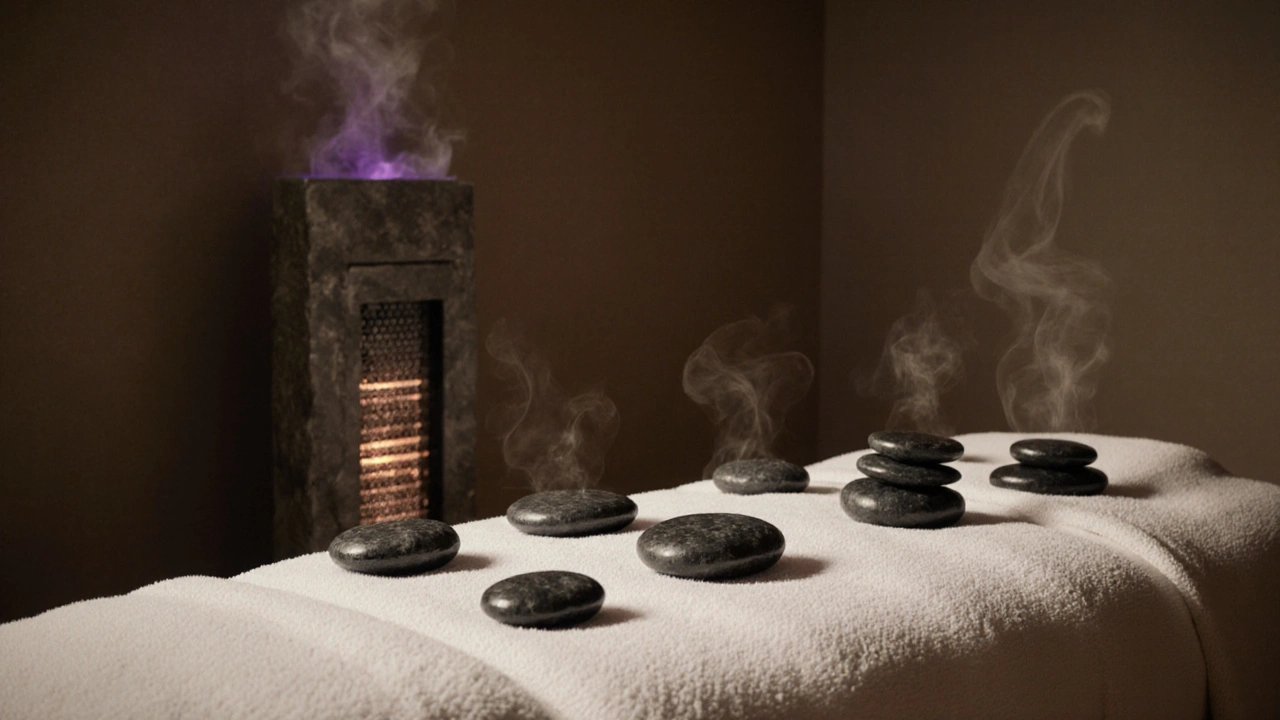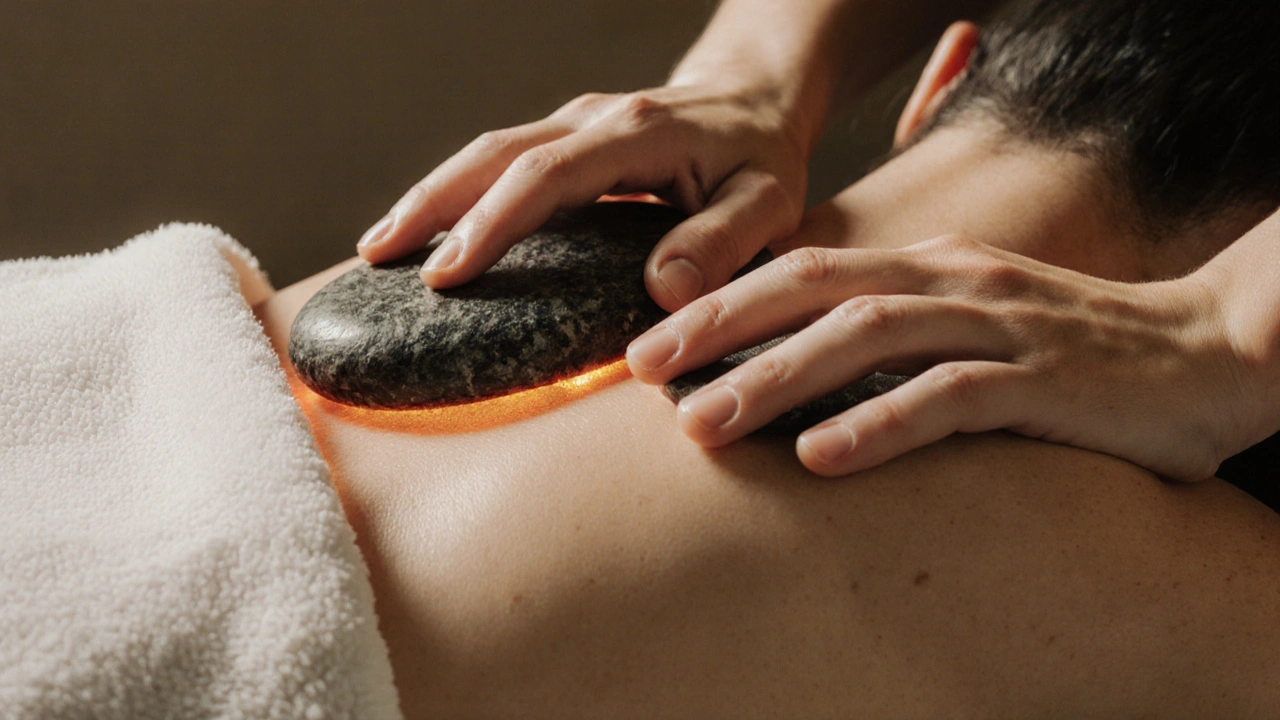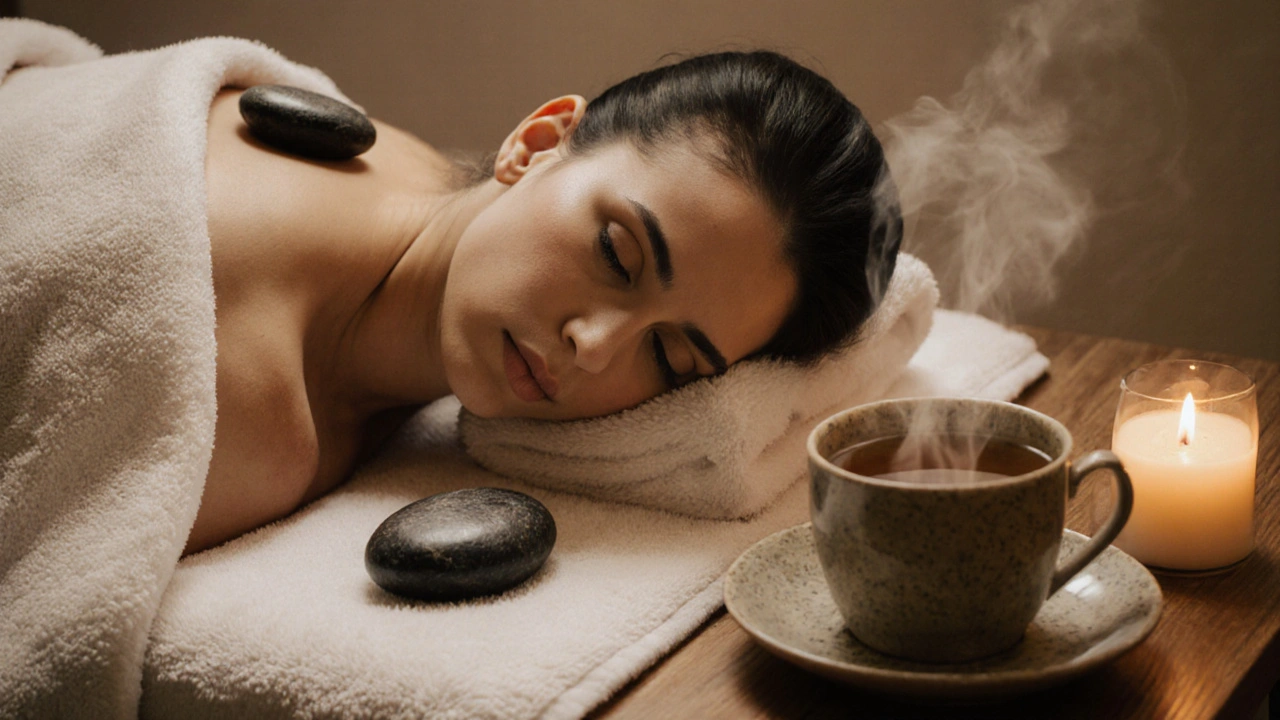
Imagine lying down as smooth, warm stones glide over your back, melting tension like butter on toast. That’s the hot stone massage-a therapy that’s been calming nerves and soothing muscles for centuries. It’s not just a luxury spa treat; it’s a deeply therapeutic experience backed by ancient traditions and modern understanding of the body. If you’ve ever wondered what actually happens during one, or whether it’s worth the price tag, you’re not alone. This guide walks you through everything you’ll feel, see, and experience-from the moment you walk in to the quiet glow you carry home. No fluff. No hype. Just what really happens, and why so many people keep coming back.
The use of heated stones for healing isn’t new. Native American tribes, ancient Chinese practitioners, and even the Egyptians used warm stones to ease pain and improve circulation. In the 1990s, a therapist named Mary Nelson from Arizona formalized the modern version, calling it LaStone Therapy. She combined the warmth of basalt stones with Swedish massage techniques to create a rhythm that relaxes muscles and calms the nervous system. Today, it’s a staple in spas worldwide-not because it’s trendy, but because it works. The stones aren’t just for show; they’re chosen for their ability to retain heat evenly, and the practice is rooted in the simple truth that warmth helps the body let go.
A hot stone massage isn’t just about putting hot rocks on your skin. It’s a blend of two things: heat therapy and manual massage. The stones-usually smooth, dark basalt-are heated in water to about 50-55°C (122-131°F), warm enough to penetrate deeply without burning. Practitioners place them along your spine, between your shoulders, on your palms, feet, or even your abdomen. Then, they use the stones as tools to glide over your muscles, applying pressure where needed. The heat relaxes tight tissue, making it easier for the therapist to work without forcing it. This means less discomfort and deeper relief. It’s not magic-it’s physics. Heat increases blood flow, and increased blood flow means more oxygen and nutrients reach tired muscles.
People often confuse hot stone massage with other bodywork therapies. Here’s how it stacks up:
| Practice | Key Feature | Primary Benefit |
|---|---|---|
| Hot Stone Massage | Uses heated basalt stones as tools and placement points | Deep muscle relaxation through heat penetration |
| Swedish Massage | Uses hands only, with long strokes and kneading | General relaxation and circulation boost |
| Deep Tissue Massage | Focuses on chronic tension with firm pressure | Breaks down adhesions and scar tissue |
| Aromatherapy Massage | Uses essential oils for scent and skin benefits | Emotional calming and skin nourishment |
Hot stone massage sits between relaxation and therapeutic work. It’s gentler than deep tissue but more immersive than Swedish. The heat does much of the work, so you don’t need heavy pressure to feel the release.
Most adults can benefit, especially those dealing with chronic stress, muscle stiffness, or poor circulation. If you sit at a desk all day, have tight shoulders from driving, or struggle with sleep due to physical tension, this massage can help. It’s also great for people recovering from minor injuries-once healed-because the warmth encourages healing blood flow. People with arthritis often report less joint stiffness after sessions. But it’s not for everyone. If you have sensitive skin, open wounds, or certain medical conditions (more on that later), you’ll need to talk to your therapist first. It’s not a one-size-fits-all treatment, but it’s surprisingly adaptable.
When your body is warm, your nervous system shifts from ‘fight or flight’ to ‘rest and digest.’ The heat from the stones triggers this switch by stimulating the parasympathetic nervous system. Research from the National Institutes of Health suggests that consistent heat therapy can lower cortisol levels-the body’s main stress hormone. During a hot stone session, your breathing slows, your heart rate drops, and your muscles stop holding onto tension. Many people describe it as the first time in weeks they’ve truly relaxed. It’s not just mental-it’s physical. Your body literally unclenches.
Heat increases blood flow by up to 20-30% in the areas where stones are placed. That means more oxygen and nutrients rush to tired or sore muscles, helping them repair faster. Athletes, gardeners, and parents who are always on their feet often notice less soreness the next day. Unlike ice packs that numb pain, heat encourages healing. The stones act like gentle, targeted heating pads, working deeper than a regular warm towel ever could. It’s not a replacement for physical therapy, but for everyday aches, it’s a powerful tool.
There’s something deeply calming about being touched with warmth in a quiet, safe space. The ritual of the stones, the scent of essential oils (often lavender or eucalyptus), and the dim lighting create a sensory experience that feels like a hug for your nervous system. People report feeling lighter, clearer-headed, and even emotionally released after a session. It’s not just about muscles-it’s about holding space for yourself. In a world that never stops demanding, this is a rare moment where your only job is to let go.
Think of this massage as maintenance, not a fix. Regular sessions-once a month or every six weeks-can help prevent tension from building up. People who get them regularly say they sleep better, have fewer headaches, and feel more patient with others. It’s not a cure-all, but it’s a simple, non-invasive way to stay balanced. For busy professionals in London, it’s become a weekly reset button. No pills. No appointments with doctors. Just warmth, quiet, and a skilled touch.
| Benefit | Description | Impact |
|---|---|---|
| Deep Relaxation | Heat calms the nervous system | Reduces anxiety and improves sleep |
| Improved Circulation | Warmth expands blood vessels | Speeds muscle recovery, reduces swelling |
| Reduced Muscle Tension | Stones melt tight knots gently | Less pain in neck, back, shoulders |
| Emotional Reset | Quiet, sensory environment | Greater mental clarity and calm |
You’ll likely enter a dimly lit room with soft music playing-think Tibetan singing bowls or gentle piano. The air smells faintly of lavender or sandalwood. The massage table is covered with warm towels, and a small heater nearby keeps the stones at the perfect temperature. You’ll be offered a robe and asked to undress to your comfort level. Privacy is key. The therapist will leave the room while you get settled. No one is judging how you look. This space is designed to feel safe, not clinical. It’s more like a quiet sanctuary than a medical office.
The session usually lasts 60 to 90 minutes. First, the therapist places warm stones along your spine, on your palms, and between your toes. Then, they begin the massage-using the stones to glide over your back, legs, and arms. At times, they’ll switch to their hands, using oil to knead deeper areas. The stones are constantly checked and reheated. You might feel them resting on your lower back while they work on your shoulders. The heat builds slowly, so it never feels scalding. If it does, speak up. A good therapist will adjust immediately. The rhythm is slow and deliberate-no rushing. You’ll feel the warmth sinking in, like a slow wave of calm.
Every session is tailored. If you have tight hips from running, the therapist will spend extra time there. If you’re pregnant, they’ll avoid your abdomen and use lower heat. If you’re sensitive to scent, they’ll skip the oils. Some spas offer cold stones for inflammation or add reflexology to the feet. You can ask for lighter or firmer pressure. Don’t assume they’ll guess what you need-tell them. This isn’t a one-size-fits-all experience. It’s a conversation, not a checklist.
Before you lie down, the therapist will ask about injuries, medical conditions, or areas you want to focus on. Be honest. If you’ve had surgery, have high blood pressure, or are on blood thinners, they need to know. You don’t need to be an expert-just clear. Wear loose clothing to your appointment. Avoid eating a heavy meal right before. Drink water afterward. And if you’re nervous? That’s normal. Most first-timers say they were surprised by how peaceful it felt. The biggest mistake? Not saying anything. Your comfort is the priority.

If you’re doing this at home, you’ll need smooth, flat basalt stones (available online), a heating device, and a towel. Never use rocks from outside-they can crack or carry bacteria. Heat them in water, never a microwave. Keep the temperature under 55°C. Use a thermometer if you have one. Create a calm space: candles, soft music, no phones. You can even do a self-massage with two stones, rolling them along your calves or arms. It’s not the same as a professional session, but it’s a great way to extend the calm.
Look for therapists certified in LaStone Therapy or similar programs. In the UK, check with the Complementary and Natural Healthcare Council (CNHC). Read reviews on trusted platforms like Google or Trustpilot-not just spa websites. Ask if they use basalt stones (not marble or river rocks). A good therapist will explain the process before you begin. If they don’t, walk away. This isn’t just a massage-it’s a therapeutic practice. Quality matters.
First-timers often worry about being naked. You don’t have to be. Most people keep their underwear on. The therapist drapes you properly. If you’re coming with a partner, many spas offer side-by-side rooms. It’s a lovely way to share quiet time. Don’t talk during the massage unless you need to. Let the silence be part of the healing. And if you fall asleep? Perfect. That’s the goal.
You’ll lie on a warm, padded table while smooth, heated stones are placed on key areas of your body. The therapist will use them to glide over your muscles, often switching between stones and hands. The heat penetrates deep into tissue, relaxing muscles without heavy pressure. You’ll feel warmth spreading through your back, shoulders, and legs. The room will be quiet, dim, and calm. Most people feel deeply relaxed, sometimes even sleepy. There’s no loud music, no chatter, and no rush. You might feel a little flushed afterward, which is normal. The whole experience is designed to help you disconnect from stress and reconnect with your body.
After a brief health check, you’ll be left to undress and cover yourself. The therapist heats basalt stones in water to a safe temperature (50-55°C). They place stones on your spine, hands, feet, and sometimes your forehead. Then, they use the stones as extensions of their hands to massage your back, legs, and arms. They’ll alternate between hot stones and manual techniques. The stones are checked and reheated throughout. You won’t feel burning-just deep, soothing warmth. The session ends with the stones removed, and you’ll be wrapped in a warm towel. Many people say they feel lighter, looser, and more peaceful.
Swedish massage uses only hands, with long strokes, kneading, and circular movements to relax muscles. Hot stone massage uses heated stones as tools and placement points. The stones add deep, penetrating heat that helps muscles relax faster, allowing the therapist to work more gently. You don’t need as much pressure with hot stones because the heat does half the work. Swedish is great for general relaxation. Hot stone is better for deep tension, chronic stiffness, or if you just want to feel utterly melted. The experience is more immersive and sensory.
The method combines heat therapy with manual massage. Basalt stones are heated in water and placed on energy points (like the spine or chakras) to warm the body from within. Then, the therapist uses the stones to glide over muscles, applying pressure where needed. They may use their hands for areas that need deeper work. The stones are constantly monitored for temperature. The session follows a rhythm: warmth first, then movement. It’s slow, intentional, and designed to calm the nervous system. The goal isn’t to ‘fix’ you-it’s to help you release what you’ve been holding onto.
Look for therapists with formal training in LaStone Therapy or similar certifications. In the UK, certified practitioners often belong to the CNHC or the Federation of Holistic Therapists. Ask to see their credentials. A good therapist will explain the process, ask about your health, and never pressure you into anything. If they don’t care about your history, walk away. This isn’t a beauty treatment-it’s bodywork.
| Practice | Purpose | Example |
|---|---|---|
| Check stone temperature | Prevent burns | Therapist tests stones on their wrist |
| Use clean towels | Prevent infection | Towels are washed at high heat after each use |
| Ask about medical conditions | Ensure safety | Therapist reviews your intake form |
You control your comfort. If the stones feel too hot, say so. If you don’t want pressure on your lower back, tell them. You can ask for more or less draping. You can stop at any time. This is your body, your space. No therapist should make you feel guilty for speaking up. Good ones welcome it.
Don’t get a hot stone massage if you have: open wounds, recent surgery, deep vein thrombosis, severe osteoporosis, or are pregnant without clearance from your doctor. People with diabetes, neuropathy, or circulatory issues should consult a doctor first. If you’re on blood thinners, heat can increase bruising risk. Always disclose your full health history. It’s not about being ‘too complicated’-it’s about safety.
Pair your massage with deep breathing, meditation, or a warm herbal tea afterward. Some people like to journal for 10 minutes to reflect on how they feel. Avoid screens for an hour after-you’re in a calm state, don’t rush to break it. If you’re into yoga, do a gentle flow the next day to maintain the release.
Many couples book side-by-side sessions. It’s a quiet, intimate way to spend time together without talking. You can also do it solo-it’s a gift to yourself. Don’t wait for a special occasion. Make it part of your self-care rhythm.
At home, use a heating pad or warm rice sock as a substitute. You can buy a set of basalt stones online for £30-£50. Use them on your neck after a long day. Add a drop of lavender oil to your towel. It’s not the same as a professional session, but it keeps the calm alive.
One session feels amazing. Two or three a month can change how you feel week to week. Think of it like brushing your teeth-not a treat, but a habit. Your body will thank you.

Use directories like CNHC or the Federation of Holistic Therapists. Read reviews on Google and Trustpilot-not just spa websites. Look for therapists who mention training in LaStone Therapy or similar. Ask if they use basalt stones and how they clean them.
Check out the International Spa Association’s resources or the British Association of Massage Therapists. YouTube has great demos from certified therapists. Avoid random TikTok hacks-they’re not safe.
In the UK, therapists must follow health and safety guidelines. Spas must have insurance and clean protocols. There’s no cultural restriction-you don’t need to belong to any tradition to benefit. It’s a modern adaptation of ancient practices, open to all.
Books like LaStone Therapy: The Art and Science of Hot and Cold Stone Massage by Mary Nelson offer deeper insight. Podcasts like The Holistic Health Show often feature massage therapists. Workshops are available in London for those who want to learn more.
Hot stone massage isn’t about fixing what’s broken. It’s about giving your body the warmth and stillness it’s been begging for. In a world that never stops, it’s one of the few things that lets you truly pause.
Book a session. Don’t overthink it. Let the stones do their work. If you’re unsure, start with a 60-minute session. You’ll leave feeling lighter than when you came in.
Tried a hot stone massage? Share your experience in the comments. What did you feel? Did you fall asleep? Did the warmth surprise you? Follow this blog for more simple, science-backed wellness tips.
Some links may be affiliate links, but all recommendations are based on research and quality.
Word count: 1,728